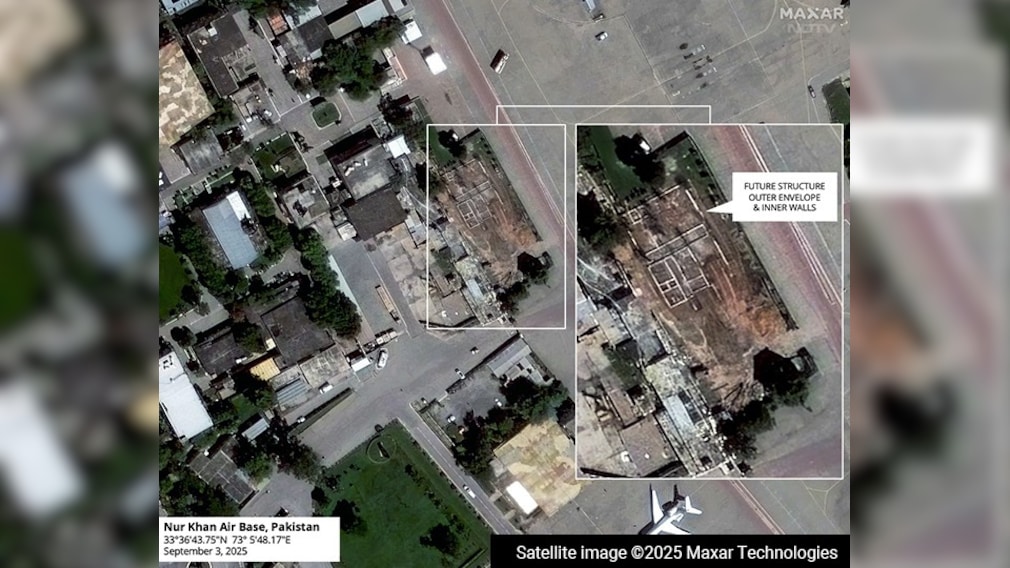Pics: Pak Rebuilds Nur Khan Base Section Destroyed By India During Op Sindoor
On May 10, India launched a missile attack targeting two special purpose trucks located within a complex.

New satellite imagery available with NDTV indicates that reconstruction activity at Pakistan's Nur Khan airbase is well underway after India's Op Sindoor strikes in May this year.
Nur Khan, a strategic airbase located less than 25 km from Islamabad, houses key assets of the Pakistan Air Force.
On May 10, India launched a missile attack targeting two special-purpose trucks located within a complex. Both the complex and the trucks, which could have been used for command and control of drone assets, were destroyed.
While India has never confirmed which missiles it used, there is a strong possibility that the facility in Nur Khan was taken out by BrahMos or SCALP air-launched land attack missiles or both. During Op Sindoor, the BrahMos was launched from the Indian Air Force's Su-30 fighters, while the SCALP was launched from the Rafale.
The sequence of images in this report indicates that the facility, which was struck, had two tractor-trailer trucks with awnings on either side before the attacks.
An image from May 10, 2025, shows that the strikes destroyed both trucks and inflicted heavy damage to neighbouring buildings.
By May 17, the site had been cleared. An image from September 3 (earlier this week) shows new construction work at the site. This includes new walls. "

A sequence of photos showing phases of reconstruction at the Nur Khan base. High res here
Recent satellite imagery suggests Pakistan has begun rebuilding the target site India struck at Nur Khan Airbase in May 2025. The Indian operation targeted specialized military vehicles housed within a facility at the airfield, resulting in their destruction and caused collateral damage to adjacent buildings. In the aftermath, several of these surrounding structures were dismantled likely due to compromised internal systems, wiring failures, or structural weakening," says the Geo Intelligence expert Damien Symon.
The IAF assault on Nur Khan was seen as both tactical and emblematic, targeting a base near the Pakistan Army's headquarters, which functions as the hub for air mobility operations. These operations encompass Saab Erieye airborne early warning systems, C-130 transport aircraft, and IL-78 mid-air refueling planes, essential for logistics, surveillance, and operational coordination.
"The current construction activity at the site reveals newly erected wall segments that are similar to the original building layout and prior architectural footprint. Given that this portion of the complex sustained only secondary damage during the strike, it is also possible that the rebuild is utilizing pre-existing foundations that remained intact and structurally viable."
India struck a host of military and terrorist targets, some deep within Pakistan, after the Pahalgam terror attack in which 26 civilians were killed on April 22.
In an address during the NDTV Defence Summit earlier this month, the Vice Chief of the Indian Air Force, Air Marshal Narmdeshwar Tiwari said the IAF had given the government a list of operational options within two days of the terror attack. On April 29, targets were shortlisted and operational planning commenced. On May 6, the armed forces had finalised the date and time of the strikes.
India's response to the Pahalgam terror attack commenced on May 7 with the IAF calibrating and escalating its response to drone and missile counter-attacks from Pak forces.
In pan-front calibrated attacks, the IAF struck up to 200 km in depth in Pakistan, the deepest attacks in Pak airspace since the 1971 war.
The IAF targeted terror centres, enemy radars, runways, and hangars housing Pakistan Air Force aircraft, forcing the Pakistani leadership to come to the ceasefire table on May 10.
-
Opinion | The Little-Known Story Of How Russia Gave Sonia Gandhi Her Name - And Changed Her Family's Fate
On Sonia Gandhi's 79th birthday, author Rasheed Kidwai throws light on her childhood, her father's years as a prisoner of war, and her early days in a little town in Italy.
-
Opinion | Invoked When Needed, Ignored When Not: How A New US Doctrine Sees India
Under the latest US National Security Strategy, India could become a convenience partner, invoked when useful and ignored when inconvenient. It can't accept that role.
-
Opinion | What The IndiGo Crisis Reveals About The Fragility Of Indian Aviation
The indelible images of passengers sleeping rough on cold terminal floors, captured and broadcast across every channel, will outlast a thousand corporate advertising campaigns by IndiGo. The urgent push for reform can no longer be ignored.
-
Opinion | IndiGo Crisis Is What Happens When Market Power Becomes Market Arrogance
IndiGo now is a de-facto monopoly in India's skies. And what comes with monopolies is conceit and extortion.
-
Opinion | Navigating the Tightrope: Why Putin's Visit Is A Masterclass In India's Foreign Policy
India's engagement with Russia is not without risks. Its decision to host the summit, nonetheless, and continue its trade ties despite overt disapproval from the West, is a clear exercise of strategic autonomy.
-
Opinion | Putin In India: Why A Fuming Europe Must Accept Its Problems Aren't Of India's Making
The initiative of the three European envoys to write an article in an Indian daily maligning Putin and Russia just before the Russian president's visit served no real purpose. It was diplomatically unwarranted.
-
Opinion | The Anti-Putin 'Op-ed': Why Europe Must Stop Lecturing India Like It's 1905
Europe has had it easy for centuries. Today, two non-European powers - the US and Russia - are deciding its fate. What really stings the old continent today is this acute feeling of impotency, a sense of irrelevance.
-
Opinion | India Still Needs Something Like Sanchar Saathi - Just Not Like This
India is experiencing what authorities describe as a "peak menace" of digital fraud. The Supreme Court recently took suo motu cognisance of digital arrest scams after victims collectively lost approximately Rs 3,000 crore.
-
Opinion | Sanchar Saathi Mess: 5 Lessons From The Centre's Spectacular Misfire
It's worrying that nobody in authority had the brains to anticipate the outrage that has dominated the public discourse in the last two days. In a way, the government has brought this blowback upon itself.
-
Opinion | Guns To Rallies, How 'Drug Money' Is Fuelling Khalistani Extremism In Canada
Since 2007, more than 200 gang-related homicides in British Columbia alone have been linked to rival Punjabi-Canadian gangs fighting for control of the lucrative cross-border drug trade
-
News Updates
-
Featured
-
More Links
-
Follow Us On










